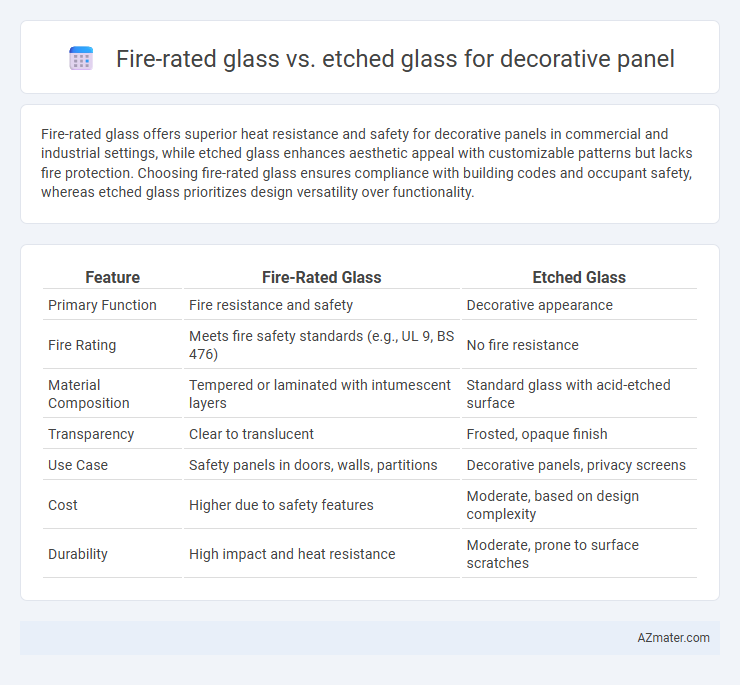Fire-rated glass offers superior heat resistance and safety for decorative panels in commercial and industrial settings, while etched glass enhances aesthetic appeal with customizable patterns but lacks fire protection. Choosing fire-rated glass ensures compliance with building codes and occupant safety, whereas etched glass prioritizes design versatility over functionality.
Table of Comparison
| Feature | Fire-Rated Glass | Etched Glass |
|---|---|---|
| Primary Function | Fire resistance and safety | Decorative appearance |
| Fire Rating | Meets fire safety standards (e.g., UL 9, BS 476) | No fire resistance |
| Material Composition | Tempered or laminated with intumescent layers | Standard glass with acid-etched surface |
| Transparency | Clear to translucent | Frosted, opaque finish |
| Use Case | Safety panels in doors, walls, partitions | Decorative panels, privacy screens |
| Cost | Higher due to safety features | Moderate, based on design complexity |
| Durability | High impact and heat resistance | Moderate, prone to surface scratches |
Introduction to Fire-Rated and Etched Glass
Fire-rated glass provides essential safety by withstanding high temperatures, making it a crucial component in fire-resistant barriers and doors to prevent the spread of flames and smoke. Etched glass, created through acid or sandblasting techniques, offers a decorative and textured finish that enhances aesthetic appeal while allowing light diffusion. Both materials serve distinct purposes in decorative panels, with fire-rated glass prioritizing safety compliance and etched glass focusing on visual design.
Key Differences Between Fire-Rated and Etched Glass
Fire-rated glass is specially designed to withstand high temperatures and prevent the spread of fire, meeting strict safety standards such as ASTM E119 or UL 972, while etched glass primarily serves an aesthetic purpose with decorative patterns created through acid or laser etching. Fire-rated glass typically consists of multiple layers including a transparent intumescent interlayer for heat resistance, whereas etched glass remains a single pane with surface modifications that do not affect its structural integrity or fire performance. The key difference lies in fire-rated glass's ability to maintain visibility and barrier function during a fire event, contrasting with etched glass's focus on artistic design without providing fire protection.
Fire-Rated Glass: Features and Benefits
Fire-rated glass provides essential fire resistance by withstanding high temperatures and containing flames for specified durations, ensuring safety in decorative panel applications. Its multi-layered construction often includes intumescent interlayers that expand during heat exposure, maintaining integrity and visibility while preventing fire spread. Beyond safety compliance, fire-rated glass enhances aesthetic appeal with clear, durable surfaces that integrate seamlessly into architectural designs without compromising design versatility.
Etched Glass: Features and Aesthetic Appeal
Etched glass offers a unique decorative appeal through its frosted, textured surface created by sandblasting or acid-etching, enhancing privacy while allowing light diffusion in interior panels. Unlike fire-rated glass, which prioritizes safety and heat resistance, etched glass emphasizes design versatility with customizable patterns, logos, and artistic effects that elevate modern architectural aesthetics. Its matte finish and delicate opacity provide a sophisticated contrast in decorative panels, making it a preferred choice for stylish, non-safety-critical applications.
Safety and Code Compliance Considerations
Fire-rated glass offers superior safety by providing critical fire resistance and preventing the spread of flames and smoke, meeting stringent building code requirements such as ASTM E-119 and NFPA 251. Etched glass, while visually appealing for decorative panels, lacks fire-resistance properties and typically does not comply with fire safety regulations in commercial and public buildings. Selecting fire-rated glass ensures both aesthetic appeal and adherence to safety codes essential for occupant protection in fire-prone environments.
Design Flexibility and Customization Options
Fire-rated glass offers limited design flexibility due to strict safety standards, but it provides essential customization options like tint, texture, and frame integration to meet building codes. Etched glass excels in design versatility, allowing intricate patterns, logos, and artwork with high precision, making it ideal for decorative panels with unique visual appeal. Both options support customization, but etched glass prioritizes aesthetic detail while fire-rated glass balances safety with design.
Applications for Decorative Panels
Fire-rated glass offers enhanced safety and compliance for decorative panels in commercial buildings, hospitals, and schools by providing visibility while meeting fire protection standards. Etched glass is preferred for aesthetic appeal in residential interiors, offices, and retail spaces, creating privacy and artistic designs without compromising light transmission. Both materials serve distinct decorative panel applications, balancing safety requirements and visual design objectives.
Cost Comparison: Fire-Rated vs Etched Glass
Fire-rated glass typically costs more than etched glass due to its specialized laminated construction and compliance with stringent safety standards, often ranging from $50 to $100 per square foot. Etched glass, on the other hand, is more affordable, usually priced between $20 and $45 per square foot, as it involves surface treatment without complex layering. The higher expense of fire-rated glass reflects its enhanced performance in fire resistance and safety certification, making it essential for areas requiring strict fire codes.
Maintenance and Durability Factors
Fire-rated glass offers superior durability and requires minimal maintenance due to its resistance to heat, impact, and scratches, making it ideal for safety-critical decorative panels. Etched glass, while visually appealing with its customized patterns, tends to be more prone to surface damage and scratches, necessitating gentle cleaning methods and more frequent upkeep. Both types benefit from regular inspections, but fire-rated glass maintains its structural integrity longer under harsh conditions and varying temperatures.
Choosing the Right Glass for Decorative Panels
Selecting fire-rated glass for decorative panels ensures compliance with safety regulations while offering heat and flame resistance, ideal for commercial spaces. Etched glass provides an elegant aesthetic with customizable patterns, enhancing privacy without compromising light transmission. Balancing functionality and design requires assessing durability needs and visual impact to choose the most suitable glass type for each project.

Infographic: Fire-rated glass vs Etched glass for Decorative panel
 azmater.com
azmater.com